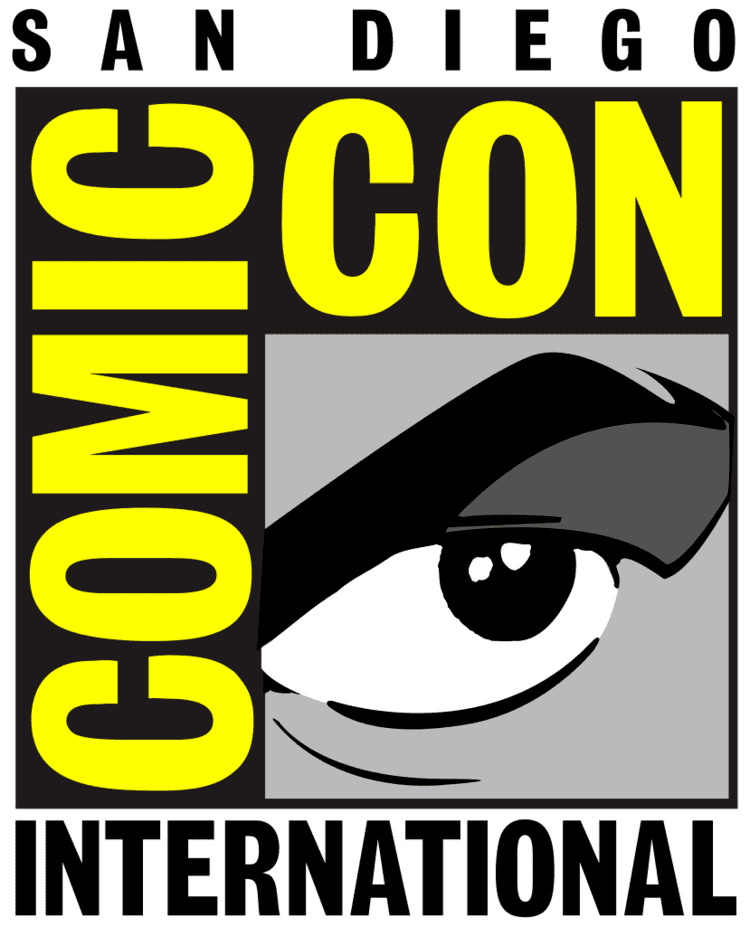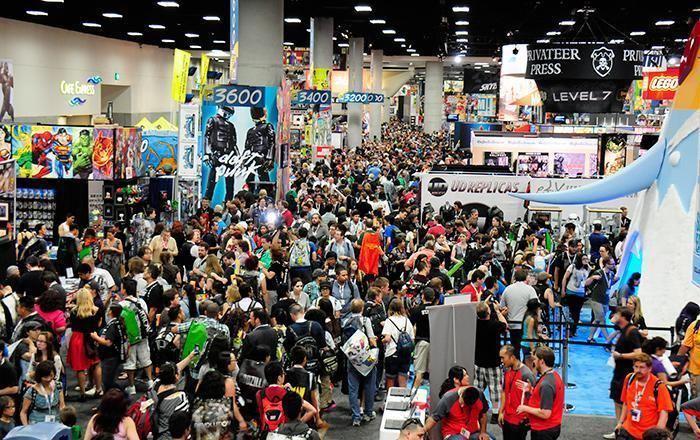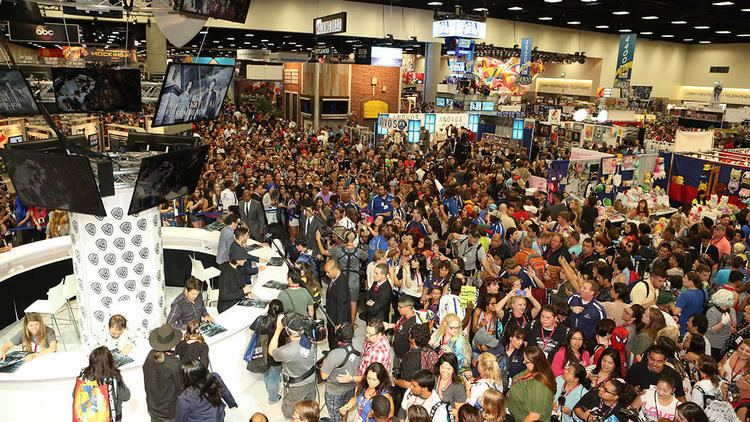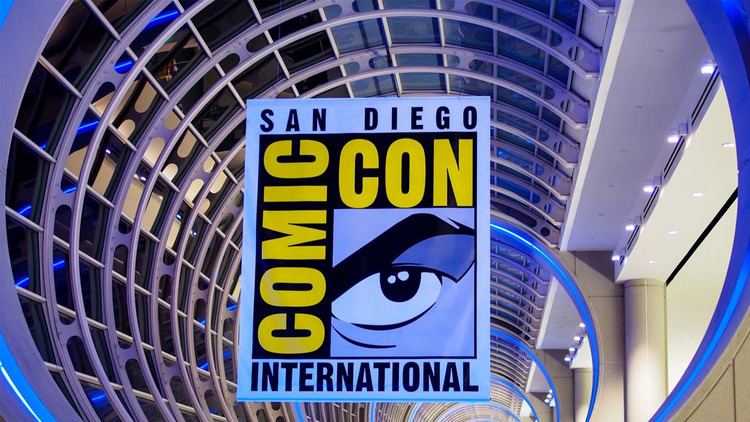Status Active Country United States Location San Diego | Genre Multi-genre Attendance Around 167,000 in 2015 | |
 | ||
Inaugurated March 21, 1970; 47 years ago (1970-03-21) (as Golden State Comic Book Convention) | ||
San diego comic con roundup 2016
San Diego Comic-Con International is a multi-genre entertainment and comic convention held annually in San Diego, California. It was founded as the Golden State Comic Book Convention in 1970 by a group of San Diegans that included Shel Dorf, Richard Alf, Ken Krueger, Marvin Nelson and Mike Towry; later, it was called the "San Diego Comic Book Convention". The name, as given on its website, is Comic-Con International: San Diego; but it is commonly known simply as Comic-Con or the San Diego Comic-Con or "SDCC". It is a four-day event (Thursday–Sunday) held during the summer at the San Diego Convention Center in San Diego. On the Wednesday evening prior to the official opening of the event, there is a preview for professionals, exhibitors, and select guests pre-registered for all four days.
Contents
- San diego comic con roundup 2016
- Best cosplay of san diego comic con 2016 marvel dc disney girls more
- History and organization
- Events
- Exclusive collectibles
- In the media
- Comic Con Magazine
- Overcrowding
- Accidents and incidents
- References

Comic-Con International also produces two other conventions, WonderCon, held in Los Angeles, and the Alternative Press Expo (APE), held in San Francisco. Since 1974, Comic-Con has bestowed its annual Inkpot Award on guests and persons of interest in the popular arts industries, as well as on members of Comic-Con's board of directors and the Convention committee. It is also the home of the Will Eisner Awards.

Originally showcasing primarily comic books and science fiction/fantasy related film, television, and similar popular arts, the convention has since included a larger range of pop culture and entertainment elements across virtually all genres, including horror, animation, anime, manga, toys, collectible card games, video games, webcomics, and fantasy novels. According to Forbes, the convention is the "largest convention of its kind in the world;" Publishers Weekly wrote "Comic-Con International: San Diego is the largest show in North America;" it is also the largest convention held in San Diego. In 2010, it filled the San Diego Convention Center to capacity with more than 130,000 attendees.

Best cosplay of san diego comic con 2016 marvel dc disney girls more
History and organization
The convention was founded in 1970 by Shel Dorf, Richard Alf, Ken Krueger, Mike Towry, Barry Alfonso, Bob Sourk, and Greg Bear. Detroit, Michigan-born, comics fan Shel Dorf, had, in the mid-1960s, mounted the Detroit Triple-Fan Fairs, one of the first commercial comics-fan conventions. When he moved to San Diego, California, in 1970, he organized a one-day convention (Golden State Comic-Minicon) on March 21, 1970, "as a kind of 'dry run' for the larger convention he hoped to stage." Dorf went on to be associated with the convention as president or manager, variously, for years until becoming estranged from the organization. Alf co-chaired the first convention with Krueger and became chairman in 1971.
Following the initial gathering, Dorf's first three-day San Diego comics convention, the Golden State Comic-Con, drew 300 people and was held at the U.S. Grant Hotel from August 1–3, 1970. Other locations in the convention's early years included the El Cortez Hotel, the University of California, San Diego, and Golden Hall, before being moved to the San Diego Convention Center in 1991. Richard Alf, chairman in 1971, has noted an early factor in the Con's growth was an effort "to expand the Comic-Con [organizing] committee base by networking with other fandoms such as the Society for Creative Anachronism and the Mythopoeic Society, among others. (We found a lot of talent and strength through diversity)." By the late 1970s, the show had grown to such an extent that Bob Schreck recalled visiting with his then-boss Gary Berman of Creation Conventions and reflecting, "While [Berman] kept repeating (attempting to convince himself) 'This show's not any bigger than ours!' I was quietly walking the floor stunned and in awe of just how much bigger it really was. I was blown away."
The convention is organized by a panel of 13 board members, 16 to 20 full-time and part-time workers, and 80 volunteers who assist via committees. Comic Con International is a non-profit organization, and proceeds of the event go to funding it, as well as the Alternative Press Expo (APE) and WonderCon. The convention logo was designed by Richard Bruning and Josh Beatman in 1995. In September 2010, the convention announced that it would stay in San Diego through 2015. In 2015, working with Lionsgate, a video channel was created to host Comic-Con related content.
According to the San Diego Convention and Visitor's Bureau, the convention has an annual regional economic impact of $162.8 million, with a $180 million economic impact in 2011.
Events
Along with panels, seminars, and workshops with comic book professionals, there are previews of upcoming feature films, and portfolio review sessions with top comic book and video game companies. The evenings include events such as awards ceremonies, the annual Masquerade costume contest, and the Comic-Con International Independent Film Festival, which showcases shorts and feature-length movies that do not have distribution or distribution deals.
Traditional events include an eclectic film program, screening rooms devoted to Japanese animation, gaming, programs such as cartoonist Scott Shaw!'s "Oddball Comics" slide show and animation expert Jerry Beck's program featuring TV's "worst cartoons ever", as well as over 350 hours of other programming on all aspects of comic books and pop culture.
Like most comic-book conventions, Comic-Con features a large floorspace for exhibitors. These include media companies such as movie studios and TV networks, as well as comic-book dealers and collectibles merchants. And like most comics conventions, Comic-Con includes an autograph area, as well as the Artists' Alley where comics artists can sign autographs and sell or do free sketches. Despite the name, artists' alleys can include writers and even models.
Academics and comic industry professionals annually hold the Comics Arts Conference at Comic-Con, presenting scholarly studies on comics as a medium.
In recent years, the number of television shows that are promoted far outnumber films. During the 2011 convention, at least 80 TV shows were represented, compared to about 35 films. The shows not only promote in the exhibit halls, but also use screenings and panels of various actors, writers, producers, and others from their shows.
While many animated shows are represented, many non-animated shows are also promoted by studios and the networks. Examples of the wide variety of TV shows recently promoted include Bones, Burn Notice, Castle, Chuck, Grimm, MythBusters, Nikita, Once Upon a Time, Psych, Supernatural, The Big Bang Theory, The Originals and The Vampire Diaries. Sci-fi TV shows are also there, such as Being Human, EUReKA, Fringe, Lost Girl, Sanctuary, Torchwood, Doctor Who, and Warehouse 13, but HBO and Showtime are also big attractions with shows like Game of Thrones, Dexter, Shameless, and True Blood.
In 2013, there were 1075 total panels held during the convention, the plurality of which were anime-focused (29%), followed by comic-focused panels (26%). 1036 vendors participated in the convention in 2013.
There are at least 17 separate rooms in the convention center used for panels and screenings, ranging in size from 280 seats to 6,100 seats. The two biggest are Ballroom 20, which seats approximately 4,900; and Hall H, which seats just over 6,100.
The neighboring Hilton Bayfront is also used, with its main ballroom (Indigo) seating up to 2,600. The other neighboring hotel, the Marriott Marquis & Marina, also hosts a lot of Comic-Con activity. Among other things, the hotel serves as the anime headquarters and is where the nighttime films are shown.
Exclusive collectibles
In the 21st century, the convention has drawn toy and collectibles designers who sell "Comic-Con Exclusive" products. Such companies have included Lego, Hasbro, Funko, Gentle Giant LTD, Mattel, National Entertainment Collectibles Association, ThinkGeek, and Sideshow Collectibles. Most such exclusives are licensed properties of movie, comic book, and animation characters.
In the media
Comic-Con International has served as the setting for Mark Hamill's Comic Book: The Movie, and for an episode of the HBO television series Entourage, the latter of which, while set at the event, was not filmed there. Comic-Con also served as an excuse for the fictional characters Seth Cohen and Ryan Atwood's trip to Tijuana, Mexico in episode 7 ("The Escape") of the first season of TV series The O.C. The convention also featured prominently as a setting for the Numb3rs episode "Graphic". In season 4 of Beauty and the Geek, an episode was featured where the contestants traveled to Comic-Con 07 and were given a challenge to create their own superheroes. In an episode of Punk'd, Hilary Swank gets Punk'd after an "attack from talking robot". In season 5, episode six, of the Showtime show Weeds, attendees from Comic-Con 2009 are seen in Silas and Doug's medicinal marijuana club.
Comic-Con featured at some length in the 2011 movie Paul which stars Simon Pegg and Nick Frost. Issue No. 72 of The Invincible Iron Man (1974) was set at the July–August 1974 Comic-Con at the El Cortez Hotel, and featured cameos by a few of the special guests.
Comic-Con is mentioned in the CBS television show The Big Bang Theory in several episodes, and in NBC's Chuck in the episode "Chuck Versus the Sandworm", as an event the characters enjoy attending. On the Futurama episode "Lrrreconcilable Ndndifferences", the main characters attend the 3010 convention (with it being referred to as "Comic-Con Intergalactic" and the iconic eye logo now sporting multiple eyes), where Fry looks for approval for his own comic while Bender attends a panel from Matt Groening (creator of Futurama as well as The Simpsons) on his new show "Futurella" (a twist on the title of the show and a parody of its cancellation by Fox).
In "It's My Party and I'll Bang If I Want To", an episode of the 2011 season of The Real World: San Diego, the cast attends Comic-Con made up as zombies in order to pass out promotional flyers for the House of Blues, where they worked as part of their season work assignment. Filmmaker Morgan Spurlock released a 2011 documentary feature film set at the convention, Comic-Con Episode IV: A Fan's Hope. Writer Robert Salkowitz also used the 2011 Comic-Con as a backdrop for his book Comic-Con and the Business of Pop Culture, an analysis of the comics industry's 21st-century dilemmas and what the future may hold.
Comic-Con Magazine
Comic-Con Magazine, formerly known as Update, is the official magazine of San Diego Comic-Con International, WonderCon, and Alternative Press Expo, published free by San Diego Comic-Con International in the United States. The seed of the Comic-Con Magazine was a short one-shot issue of The Spirit, based on Comic-Con and sold exclusively in 1976 at the San Diego Comic-Con International. The Comic-Con Magazine debuted as Update in July 2005 and mainly focused on the winners of the Eisner Awards. The last Update issue appeared in July 2008; then it went on hiatus. When it came back, it was as Comic-Con Magazine, which not only covered San Diego Comic-Con International, but also WonderCon and the Alternative Press Expo, more commonly known as APE. The new Comic-Con Magazine features interviews with Comic-Con attendees and complete coverage of the Comic-Con events. The fourth issue of Comic-Con Magazine was a hybrid with Comic-Con's Souvenir Book with cover art by Alex Ross, in full color and exclusive to Comic-Con attendees.
Overcrowding
Capacity attendance at Comic-Con in 2006 and 2007 has caused crowding issues. Concerns have been raised that the event is possibly too massive for the San Diego Convention Center, Comic-Con's home through at least 2016. In 2006, Comic-Con, for the first time, had to close registration for a few hours on Saturday to accommodate crowds. In response, for 2007, Comic-Con introduced a new three-day membership that did not include Saturday. Nevertheless, the 2007 show went on to sell out Saturday, as well as Friday and Sunday for the first time. Additionally, both the four-day and three-day memberships sold out for the first time. For 2008, the three-day memberships were abandoned and the convention decided to sell memberships only in advance, with no on-site registration. In 2008, all memberships were sold out before the convention for the first time ever. This sellout has given rise to the new phenomenon of Comic-Con memberships being scalped for exorbitant prices on websites such as eBay and Craigslist.
In April 2008, David Glanzer, Comic-Con's director of marketing and public relations, commented on the organization's desire to remain in San Diego:
We've been approached by other cities, [but] I don't think anybody wants to leave San Diego. I certainly don't. It's a perfect fit for us. It's expensive, whether it be paying for the street signs that tell you what streets are closed, or for any police or the hall or any of the myriad things, it's expensive. But it's a great city. There's been some talk of expansion of the center, which we would certainly welcome. Hopefully if everything lines up, we will be here for many more years.
Heidi McDonald reported on her blog The Beat as of October 7, 2009, Preview Night for the 2010 show had already sold out. Glazner explained the early sell-out:
For 2010 the decision was made to offer an option (of whether they wanted to attend Preview Night) to those who pre-registered for four-day badges. We limited the number of badges for Preview Night to the number of those who attended in 2008.
Mark Evanier on his blog News from ME noted as of November 9, 2009, that all 4-day passes for the 2010 show had already been sold out. On February 23, 2010, The Orange County Register reported that the larger Anaheim Convention Center in Anaheim would be making a bid to become the new home of Comic-Con starting in 2013. On September 30, 2010, Comic Con announced that they had extended their stay up to 2015. The North County Times reported on July 26, 2010, that 4-day passes with access to Preview night for the 2011 Convention had sold out two hours before the 2010 convention closed. Comic-Con International announced that 4-day passes for the 2014 convention (July 24–27) would no longer be available and only single days would be sold. Due to overcrowding, organizers of the event capped attendance; this cap has been in place since 2007.
As of October 2013, a $520 million proposed expansion to the San Diego Convention Center received approval from the California Coastal Commission. The proposed expansion would increase the available space within the convention center and had a target completion date of early 2016. The expansion would add approximately 225,000 square feet of exhibit space, an additional 35%; and a brand-new 80,000 square foot ballroom, 20% larger than Hall H. The plan would also add a second tower to the Hilton Bayfront hotel, adding 500 rooms adjacent to the Convention Center. Due to the proposed expansion of the convention center, Comic Con extended its contract for San Diego to 2016. In 2014, convention center expansion was halted due to a lawsuit. As of July 2015, convention center expansion is effectively frozen, partly because the city no longer has financing lined up for it (any financing plan would involve taxpayer money and would have to be approved by a public vote), and partly because the city lost the rights to the only contiguous parcel of land where expansion could occur. Other cities, including Los Angeles, began to seek to have Comic-Con move out of San Diego; In 2015, Comic-Con entered into negotiations with San Diego. As a result of these negotiations, Comic-Con entered into a contract to stay in San Diego through 2018.
Accidents and incidents
In 2010, an individual crossing at a red light was hit by car and killed in the days leading up to the convention. In 2013, a young woman attempted to jump off the balcony of a local high-rise, but nearby stuntmen prevented it.
In 2014, multiple pedestrians marching in Comic-Con's ZombieWalk were struck by a car forcing its way through an intersection. A 64-year-old woman sustained serious injuries to her arm; two others had minor injuries.
A teenage cosplayer was initially thought to have been sexually assaulted early Sunday morning, and a suspect was arrested on Sunday at the San Diego Marriott Hotel and Marina. Police later stated that the teenage girl was injured in a fall; the arrested individual was charged, according to NBC San Diego, with "sexual contact with a minor and providing her alcohol".
